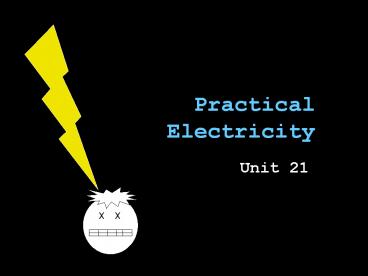Practical Electricity - PowerPoint PPT Presentation
Title:
Practical Electricity
Description:
Practical Electricity Unit 21 x x Outline Power Electrical energy transfer Resistive dissipation Summing power Heating effect Paying for electricity POWER!!!! – PowerPoint PPT presentation
Number of Views:107
Avg rating:3.0/5.0
Title: Practical Electricity
1
PracticalElectricity
- Unit 21
x x
2
Outline
- Power
- Electrical energy transfer
- Resistive dissipation
- Summing power
- Heating effect
- Paying for electricity
3
POWER!!!!
4
Work done
- Potential difference ?
5
Work done
- Potential difference Work done per unit charge
- W V Q
6
Power
- Power Work done / unit time
- V Q / t
- V I
7
Power Electrical Energy Transfer
- P I V
- Watt is the unit?
8
Power Resistive Dissipation
- P I V
- Use Ohms Law
- P I2 R
- P V2 / R
9
Power Electrical Energy Transfer vs. Resistive
Dissipation
- Title too long
10
A question
- A potential difference V is connected across a
resistance R, causing current I through the
resistance. Rank the following variations
according to the change in the rate at which
electrical energy is converted to thermal energy
in the resistance, greatest change first - V doubled, R unchanged
- I doubled, R unchanged
- R doubled, V unchanged
- R doubled, I unchanged ab/d/c
11
Another question
- You are given a length of uniform heating wire
made of Nichrome with a resistance of 72 ohms. At
what rate is energy dissipated in the following
scenarios - A p.d. of 120 V is applied across the full length
of the wire. - The wire is cut in half, and a p.d. of 120 V is
applied across the length of each half. - 200,400
12
Another question
- You are given a length of uniform heating wire
made of Nichrome with a resistance of 72 ohms. At
what rate is energy dissipated in the following
scenarios - A p.d. of 120 V is applied across the full length
of the wire. - The wire is cut in half, and a p.d. of 120 V is
applied across the length of each half. - Heat output power why not cut?
13
Yet another question
- A wire of length L 2.35 m and diameter d 1.63
mm carries a current I of 1.24 A. The wire
dissipates electrical energy at the rate P of
48.5 mW. What is the resistivity of the material? - 2.8x10-8ohmmetres (Al)
14
Heating Effect of Electricity
15
Heating effect video
- High / low resistance?
- Why doesnt it melt / explode?
16
Characteristics of heating element
- Nichrome
- Coiled around some kind of insulating,
fire-proof material - Silica, mica, RI boys
- High melting point
- High resistance
17
Applications of heating effect
- Electric kettle heating element enclosed in a
metal tube, water gets heated by conduction and
convection - Electric iron heat generated by the heating
element is spread evenly over a metal base
(chromium plated)
18
Applications of heating effect
- Filament/incandescent lamp Tungsten (why?)
coiled up (why?) in glass filled with
argon/nitrogen (WHY?!), casts sharp shadows - Fluorescent lamp No filament (WHYY?!?!1one),
vapour emits UV light (isnt that invisible?),
casts soft shadows
19
Incandescent light bulb vs. fluorescent lamp
- Both are rated at 40 W. Which puts out the most
light?
20
Thick and Thin
- Two incandescent bulbs A and B are identical in
all ways except Bs filament is thicker than As.
If both are screwed into 110V sockets, which will
be brighter? Why?
21
60 W bulb vs. 100 W bulb
- If connected in series, why is the 60 W bulb
brighter? (Higher power rating higher or lower
resistance?)
22
Paying for electricity
23
Kilowatt-hour
- Energy used by a device at a rate of 1000 watts
in one hour - SingPower 16 cents per kWh
24
Kilowatt-hour
- 1 kW h
- (1000 W) (3600 s)
- 3600000 W s
- 3600000 J
25
QuestionPaying the bills
- How much would you have to pay the Public
Utilities Board if you used two 40 W lamps and a
120 W television for 5 hours a day for the month
of March? (Assume the cost of 1 kWh of energy to
be 16 cents.) - Consider Series? Parallel? How to add?
26
Conclusion
- Heating effect
- Power
- Electrical energy transfer
- Resistive dissipation
- Summing power
- Paying for electricity































